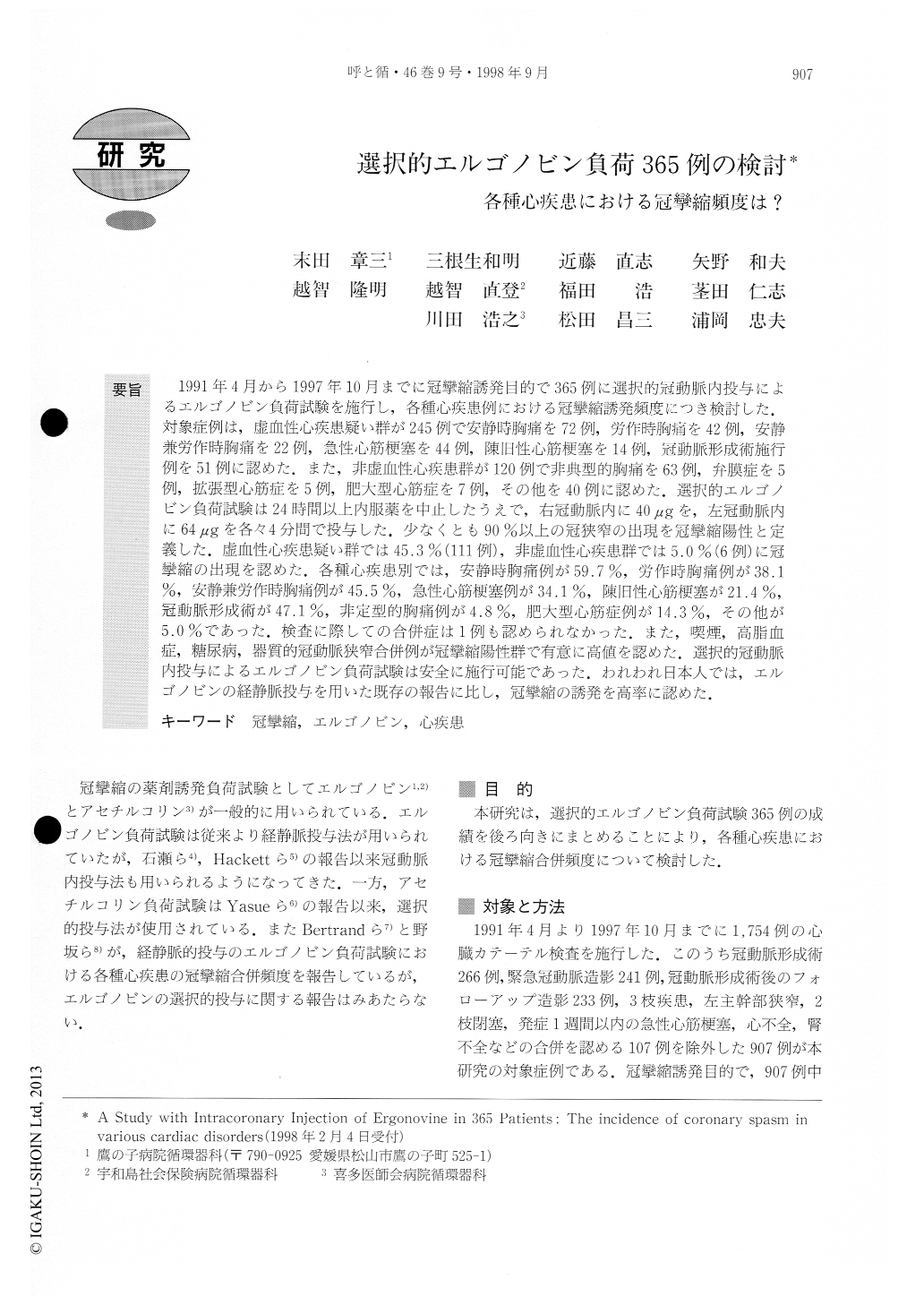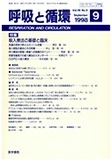Japanese
English
- 有料閲覧
- Abstract 文献概要
- 1ページ目 Look Inside
1991年4月から1997年10月までに冠攣縮誘発目的で365例に選択的冠動脈内投与によるエルゴノビン負荷試験を施行し,各種心疾患例における冠攣縮誘発頻度につき検討した.対象症例は,虚血性心疾患疑い群が245例で安静時胸痛を72例,労作時胸痛を42例,安静兼労作時胸痛を22例,急性心筋梗塞を44例,陳旧性心筋梗塞を14例,冠動脈形成術施行例を51例に認めた.また,非虚血性心疾患群が120例で非典型的胸痛を63例,弁膜症を5例,拡張型心筋症を5例,肥大型心筋症を7例,その他を40例に認めた.選択的エルゴノビン負荷試験は24時間以上内服薬を中止したうえで,右冠動脈内に40μgを,左冠動脈内に64μgを各々4分間で投与した.少なくとも90%以上の冠狭窄の出現を冠攣縮陽性と定義した.虚血性心疾患疑い群では45.3%(111例),非虚血性心疾患群では5.0%(6例)に冠攣縮の出現を認めた.各種心疾患別では,安静時胸痛例が59.7%,労作時胸痛例が38.1%,安静兼労作時胸痛例が45.5%,急性心筋梗塞例が34.1%,陳旧性心筋梗塞が21.4%,冠動脈形成術が47.1%,非定型的胸痛例が4.8%,肥大型心筋症例が14.3%,その他が5.0%であった.検査に際しての合併症は1例も認められなかった.また,喫煙,高脂血症,糖尿病,器質的冠動脈狭窄合併例が冠攣縮陽性群で有意に高値を認めた.選択的冠動脈内投与によるエルゴノビン負荷試験は安全に施行可能であった.われわれ日本人では,エルゴノビンの経静脈投与を用いた既存の報告に比し,冠攣縮の誘発を高率に認めた.
We perfomed selective intracoronary injection of ergonovine for 365 patients to clarify the incidence of coronary spasm in various cardiac disorders in Japanese patiens, from April, 1991 to October, 1997. We studied 245 patients strongly suspected of having ischemic heart disease. They included 72 patients with angina at rest, 42 patients with angina on effort, 22 patient who had angina both at rest and on effort, 44 patients who had suffered from acute myocardial infarction within 1 month from onset, 14 patients with old myocardial infarction (>1 month), and 51 patients who had under-gone percutaneous transluminal coronary angioplasty. We also examined 120 patients with non-ischemic heart disease, including 63 patients with atypical chest pain, 5 patients with valvular heart disease, 5 patients with dilated cardiomyopathy, 7 patients with hypertrophic cardiomyopathy and another 40 patients. Under no medication for at least 24 hours, ergonovine was inject-ed in total closes of 40μg into the right coronary artery and of 64 μg into the left coronary artery for 4 minutes.We defined spasm as positive with more than 90% luminal narrowing. Spasm was provoked in 45.3% of patients with ischemic heart disease and in 5.0% of patients with non-ischemic heart disease. The incidence of coronary artery spasm was 59.7% in rest angina, 38.1% in effort angina. 45.5% in rest and effort angina, 34.1% in acute myocardial infarction, 21.4% in old myocardial infarction, 4.8% in atypical chest pain, 14.3 % in hypertrophic cardiomyopathy and 5.0% in other patients respectively. No serious complication occurred in the procedures. The patients with spasm had significantly higher incidence of habitual smoking, hyperlipidemia, diabetes mellitus and organic coronary stenosis (≧75 %) than the patients without spasm.

Copyright © 1998, Igaku-Shoin Ltd. All rights reserved.


